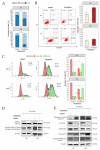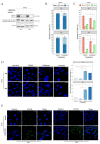CHIR99021, trough GSK-3β Targeting, Reduces Epithelioid Sarcoma Cell Proliferation by Activating Mitotic Catastrophe and Autophagy
- PMID: 34681807
- PMCID: PMC8538073
- DOI: 10.3390/ijms222011147
CHIR99021, trough GSK-3β Targeting, Reduces Epithelioid Sarcoma Cell Proliferation by Activating Mitotic Catastrophe and Autophagy
Abstract
Epithelioid sarcoma (ES) is a rare disease representing <1% of soft tissue sarcomas. Current therapies are based on anthracycline alone or in combination with ifosfamide or other cytotoxic drugs. ES is still characterized by a poor prognosis with high rates of recurrence. Indeed, for years, ES survival rates have remained stagnant, suggesting that conventional treatments should be revised and improved. New therapeutic approaches are focused to target the key regulators of signaling pathways, the causative markers of tumor pathophysiology. To this end, we selected, among the drugs to which an ES cell line is highly sensitive, those that target signaling pathways known to be dysregulated in ES. In particular, we found a key role for GSK-3β, which results in up-regulation in tumor versus normal tissue samples and associated to poor prognosis in sarcoma patients. Following this evidence, we evaluated CHIR99021, a GSK-3 inhibitor, as a potential drug for use in ES therapy. Our data highlight that, in ES cells, CHIR99021 induces cell cycle arrest, mitotic catastrophe (MC) and autophagic response, resulting in reduced cell proliferation. Our results support the potential efficacy of CHIR99021 in ES treatment and encourage further preclinical and clinical studies.
Keywords: CHIR99021; GSK-3β inhibition; autophagy; epithelioid sarcoma; mitotic catastrophe.
Conflict of interest statement
The authors declare no conflict of interest.
Figures








References
-
- Needs T., Fillman E.P. StatPearls. StatPearls Publishing; Treasure Island, FL, USA: 2019. Cancer, Epithelioid Sarcoma. - PubMed
-
- Guillou L., Wadden C., Coindre J.M., Krausz T., Fletcher C.D. “Proximal-Type” Epithelioid Sarcoma, a Distinctive Aggressive Neoplasm Showing Rhabdoid Features. Clinicopathologic, Immunohistochemical, and Ultrastructural Study of a Series. Am. J. Surg. Pathol. 1997;21:130–146. doi: 10.1097/00000478-199702000-00002. - DOI - PubMed
MeSH terms
Substances
Grants and funding
LinkOut - more resources
Full Text Sources
Medical

